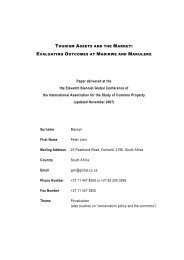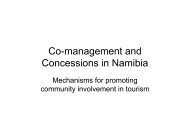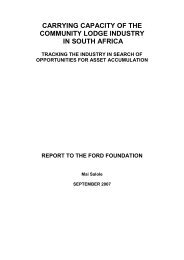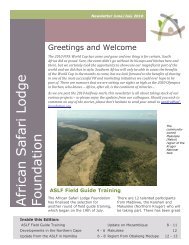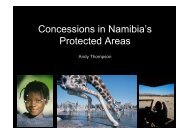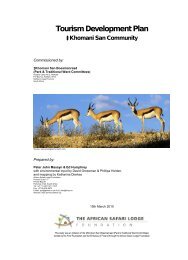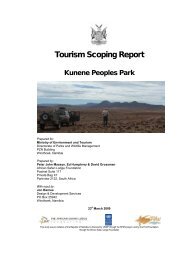socio-economic research on manda wilderness, lago district, niassa ...
socio-economic research on manda wilderness, lago district, niassa ...
socio-economic research on manda wilderness, lago district, niassa ...
Create successful ePaper yourself
Turn your PDF publications into a flip-book with our unique Google optimized e-Paper software.
whereas most schools inland (4) are temporary structures made of traditi<strong>on</strong>al materials. MW built most<br />
(71%) of the permanent schools in 5 villages to date: Uchesse, Mataka, Mala, Mbueca and<br />
Mandambuzi.<br />
Additi<strong>on</strong>al data for Mandambuzi and Mbueca was obtained through interviews with school teachers.<br />
No teacher was available in Mala. Comprehensive and well <str<strong>on</strong>g>research</str<strong>on</strong>g>ed data provided by the teacher in<br />
Mbueca, Mr. Felix Mwajollo, is presented below.<br />
Table 8 Educati<strong>on</strong> Enrolment and Literacy Indicators for Mbueca Village<br />
Indicator Mbueca Village<br />
a) Total number of children attending school 200<br />
b) Number of girls 97<br />
c) Number of boys 103<br />
d) Number of teachers 2<br />
e) Teacher/pupil ratio 51.5<br />
f) Building type Permanent<br />
g) Number of classrooms 2<br />
h) Number of classes (standards) 5<br />
i) Average class size 40<br />
j) Estimate of net primary enrolment ratio (%) 80%<br />
k) Average number of hours in school per week -<br />
l) Estimate of net sec<strong>on</strong>dary enrolment ratio (%) 26%<br />
m) Estimate of the adult literacy rate 12-15%<br />
n) Estimate of the youth literacy rate 8-11%<br />
The number of children attending school varies (falls to 190) as attendance is irregular. This is<br />
because boys may fish and girls can be kept at home to do domestic work. The school and committee<br />
are pro-active in encouraging attendance. Most children complete their primary educati<strong>on</strong> (standard 6<br />
and 7) in Ngoo village or Cobue. Only <strong>on</strong>e quarter of children c<strong>on</strong>tinue to sec<strong>on</strong>dary educati<strong>on</strong> due to a<br />
lack of income to pay school fees.<br />
3.2.9 Indicator 9: Infrastructure and Communicati<strong>on</strong>s<br />
These indicators were included as local <str<strong>on</strong>g>ec<strong>on</strong>omic</str<strong>on</strong>g> growth in Niassa Province, like most other parts of<br />
Mozambique, is significantly c<strong>on</strong>strained by n<strong>on</strong>-existent and/or inadequate transport infrastructure and<br />
communicati<strong>on</strong>s.<br />
a) Number of all weather roads (usable in all seas<strong>on</strong>s in a 2 wheel drive vehicle).<br />
b) Number of roads usable <strong>on</strong>ly in the dry seas<strong>on</strong> and/or with 4 wheel drive.<br />
c) Mobile ph<strong>on</strong>e network coverage.<br />
d) Number of satellite dishes.<br />
Three villages are located <strong>on</strong> a main all weather graded road between Metangula and Cobue:<br />
Mandambuzi, Litanda and Khango. Mbueca is linked to Mandambuzi by a track usable in the dry<br />
seas<strong>on</strong> c<strong>on</strong>structed by MW. There is no mobile teleph<strong>on</strong>e network in the villages. There is a satellite<br />
dish in Mbueca and Khango.<br />
3.3 Participatory M<strong>on</strong>itoring and Evaluati<strong>on</strong><br />
There are no formal m<strong>on</strong>itoring and evaluati<strong>on</strong> systems to evaluate the impacts of MW community<br />
development projects such as primary schools and the dem<strong>on</strong>strati<strong>on</strong> farm. More systemised and<br />
participatory m<strong>on</strong>itoring and evaluati<strong>on</strong> could provide data that would be useful for measuring ASL’s<br />
future impact and be a development tool for communities, for example, the MW village committees<br />
could m<strong>on</strong>itor educati<strong>on</strong> enrolment and literacy indicators.<br />
The traditi<strong>on</strong>al approach to evaluati<strong>on</strong> practiced by d<strong>on</strong>or agencies renders n<strong>on</strong>-existent the role of<br />
participant groups. For instance, an organizati<strong>on</strong> enters a community, carries out its activities by<br />
soliciting participati<strong>on</strong> from the intended beneficiaries and when the time comes to close the project,<br />
14



